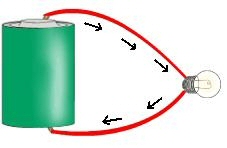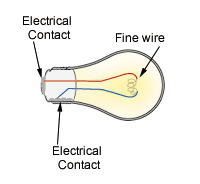 Wires and
switches The current has to stay inside a conductor. So we
can guide the current to the place we want, using wires.
Wires and
switches The current has to stay inside a conductor. So we
can guide the current to the place we want, using wires.For an electrical circuit to do something, there must be an electrical current: something is flowing in the wires. We imagine an "electrical fluid" that emerges from the positive end of the battery. The electrical fluid is called charge; what is actually moving are electrons (it is a small complication that we will ignore hereafter that the electrons actually are going the opposite direction from the current itself. There is no experiment we can do here that can reveal which way things are going.) The electrical current in a wire is the amount of charge that passes down it in a second, and is measured in a unit called ampere. It is the electrical analog of the flow rate of a liquid -- like gallons per minute. The light bulb in your kit, connected to two batteries (as in a flashlight) has a current of 0.33 Amperes. A car battery produces a current of several hundred amperes while starting the engine.

Just as the amount of water that comes out one end of a pipe is the same as the amount of water that is entering the other end, the electrical current is the same at every point along a wire. That's why we have to have a circuit to get an electrical device to work. We will discuss energy and power later, but we should emphasize now that current and energy are not the same thing. Energy gets from the battery to the light bulb, but the current is the same before the light bulb and after the light bulb.
We have met several electrical devices in this section.
 Wires and
switches The current has to stay inside a conductor. So we
can guide the current to the place we want, using wires.
Wires and
switches The current has to stay inside a conductor. So we
can guide the current to the place we want, using wires.
 A
battery is a way to turn chemical energy into electrical
energy. We will study them in the next section. Their equivalent in
the siphon system was the difference in height between the two
water levels being connected.
A
battery is a way to turn chemical energy into electrical
energy. We will study them in the next section. Their equivalent in
the siphon system was the difference in height between the two
water levels being connected.
 A light
bulb has a very fine wire made of tungsten, sealed in an
inert gas atmosphere. When there is a current in the wire,
electrical energy is converted to heat, which makes the wire
extremely hot -- almost 1000oF! Objects this hot give
off visible light, and there is your light bulb. The fine wire is
in the form of a coil, and the symbol for a light bulb is a picture
of this, too. The two ends of the fine wire are connected to the
two electrical contacts on the base of the light bulb, so that there
is a way for the current to get into the bulb and back out.
A light bulb turns
electrical energy into heat no matter which way the current
is going. A light
bulb has a very fine wire made of tungsten, sealed in an
inert gas atmosphere. When there is a current in the wire,
electrical energy is converted to heat, which makes the wire
extremely hot -- almost 1000oF! Objects this hot give
off visible light, and there is your light bulb. The fine wire is
in the form of a coil, and the symbol for a light bulb is a picture
of this, too. The two ends of the fine wire are connected to the
two electrical contacts on the base of the light bulb, so that there
is a way for the current to get into the bulb and back out.
A light bulb turns
electrical energy into heat no matter which way the current
is going. |
 |
 A
motor lets us turn electrical energy into mechanical
energy. Inside the motor you would find magnets and electromagnets,
which we will study later.
A
motor lets us turn electrical energy into mechanical
energy. Inside the motor you would find magnets and electromagnets,
which we will study later.
Current in Circuits
We cannot see electrical current, and so it is not entirely clear what is happening when we make a circuit. The activities in this section have tried to make the electrical current real. There really is something flowing in the wires.
In the first set of explorations (Electrical currents and simple circuits), we found that we must make a circuit before anything can happen. The current must stay in the wires, and has to go somewhere; we can only have current through a device if the current can circulate through it and through the battery (which provides energy).
Check the box when you are
done:
Next:discussion of electrical current